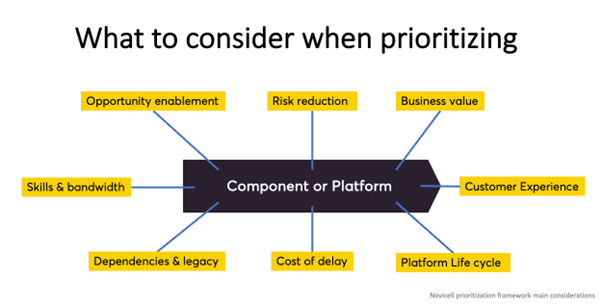In an economic downturn with volatility continuing to rock global markets, CIOs and his/her C-suite colleagues are bracing for continued tough times as we look ahead in 2023. That calls for revisiting budgets, revisiting vendor relationships in preparation for potential cut-backs and certainly also for protecting market power and relentlessly hunt all possible sales opportunities.
In an economic downturn, nothing hurts as much as when the orders slow to a trickle. The essence of an economic contraction is that the aggregated demand declines which translates into a drop in sales for businesses. Thus, protecting your fair share of the market and setting yourself up for success with new initiatives or bold moves is of immense importance.
In general, uncertain market conditions mean that businesses need to act and react fast. And actually, history has taught us that volatility and uncertainties is a constant factor. Just think of the year 2000 IT crisis, the financial crisis in 2008, the pandemic taking off in 2019 and now the perfect storm with a potential recession coming up in 2023. Though, it is an imperative to prepare for unpredictability, and the best way to do this is to build flexibility and resilience in your organisation.
As a CIO, you can pave the way for this by ensuring maneuverability and agility, among others, in your enterprise technology stack. Thus, the safe way to do this is to apply the principles of MACH (Microservices, API-first, Cloud native SaaS, Headless).
Over the past two years, MACH has moved from a nascent concept to a now globally accepted tech standard that in many ways guides IT-related best practices for digital commerce and is recognised for representing the most maneuverable IT architecture.
Just to remind you as a CIO: Most likely, your decisions may have the biggest impact on the future of your company!
How to set yourself up for success in unpredictable times
While economic downturns have disparate effects for different companies, most businesses will be concerned about maintaining their profitability and sustainability. Typically, this means taking steps in several activities in the business like improving the cash flow, reducing fixed costs, increase efficiency – meanwhile also looking thoroughly on the market and sales activities to ensure serving customers efficiently, protecting market share and potentially exploiting the situation to grab new customer segments.
Needless to say, all of these actions require being responsive to change. Being agile, being able to respond, being able to adapt is somewhat easier the more flexibility and robustness you have built into your organisation. One important element here is your IT architecture.
IT architecture based on the MACH principles is designed to be adaptive and to be able to quickly respond to changes in the environment. Applications can be broken down into small, independent components that can be independently deployed and updated. This makes it easier to quickly adapt applications to changing market conditions, changing requirements or technology changes.
For companies that have already made investments in flexible IT architecture, the ability to react to a changing market is more within reach.
For companies with a rather rigid or monolithic architecture, an economic downturn with difficult market conditions might actually make up a good time to break old paradigms and alter the digital architecture. That, of course, requires buy-in from other leadership, which can be tricky with cost pressures lingering. (However, on the other hand, your argumentation will most likely be more compelling in case you have been facing several situations where maneuverability was required but non-existing)

How MACH architecture manages resilience
MACH architecture is a modern approach to application development and deployment that is designed to be resilient and reliable. The architecture includes components such as service meshes, microservices, API gateways, and cloud that enable applications to be deployed quickly and safely.
MACH is designed to be adaptive and to be able to quickly respond to changes in the environment. As mentioned, applications can be broken down into small, independent components. These can then be independently deployed and updated which makes it easier to adapt applications to changing requirements or technology changes quickly. Additionally, the automation tools and monitoring services provide further flexibility and reliability when adapting applications to changing conditions.
The MACH architecture patterns are the most resilient option because they are designed to be robust, fault tolerant, and highly available. MACH architectures are built to be distributed and scalable. Additionally, they are designed with redundancy to handle high levels of traffic and to ensure that data is always backed up and recoverable. Finally, MACH architectures are designed to be secure and can be configured to provide end-to-end encryption, making them an excellent choice for enterprise solutions. And as it’s relatively easy to maintain, it requires less human intervention which helps to reduce costs.
Life extending legacy by encapsulating in MACH landscapes
In essence, MACH Architecture is a recession-resilient architecture approach – and resilient to any other future unpredictable situation – mainly due to composability, scalability, and adaptability. It allows businesses to maximize their resources, easily make adjustments in their go-to-market approach and create aesthetically pleasing structures that are cost-effective and resilient to economic downturns.
An added benefit in MACH architecture is separation of concerns of existing legacy components that are encapsulated within a MACH landscape. By choice or necessity, some legacy components typically coexist within a MACH based landscape. They are, however, isolated by design through the API-first patterns of MACH, and thus, easier to life-extend at a lower running cost. In many cases, this even makes legacy components evergreen and can postpone large investments in decommissioning and replatforming components, applications, or services.
How to transition gradually but sufficiently fast
Breaking up a monolith and going composable requires a solid plan, the right architectural principles, an overview of your current dependencies between systems and services, and, most importantly, it requires tangible insights into how you want to deliver true customer value. Going composable and MACH is the ticket to serve your customers in an up-to-date, best-in-class way.
Many enterprises, before you, have broken up their monoliths. Thus, the message here is clear: It is doable. And it is an operation you want to plan carefully and cost-effectively because you need to keep your business running seamlessly whilst undertaking the shift from the monolith to a composable architecture.
In any transformation, a good understanding of your baseline is key. Building the baseline means mapping all current systems in your digital landscape. Changing every component at once is not an option; therefore, an up-to-date status on what components need changing and the expected lifetime of the components or systems are necessary.
We recommend that you assess:
- Interdependencies between systems
- Legacies in your system architecture
- Existing plans for modernization or changes to processes

In Novicell, we use our prioritization framework (figure above) for mapping interdependencies between systems, old or new. For each component, we assess the business value, risk, current customer experience, and last, but not least, what opportunities there are to optimize existing systems.
Migrating from a monolithic architecture to a MACH architecture can be a complex process. The first step is to break down the monolith application into smaller, independent components, which can then be individually deployed and managed. Then, tools such as service meshes, microservices, API gateways, and containers need to be implemented, which will allow the application to be deployed in a distributed and scalable manner. Finally, automation tools and monitoring services need to be set up to ensure that the application remains reliable and resilient in the face of changes and system failures.
The transition to MACH architecture can often be faster than the transition to other architectures, but it does require the right skills and expertise to plan and implement the changes. Additionally, organisations should be sure to assess their existing infrastructure and consult with experienced professionals to ensure that their transition to MACH is as successful as possible. Planning makes perfect, so start by taking the time to assess your infrastructure and determine what needs to be done to make it MACH compatible. Once, you’ve done that, you can start making the necessary changes to ensure a successful transition.
By then, you have successfully started the journey of your business to be resilient and have maneuverability to overcome future crisis and unpredictable period of times.
Interested in hearing more?
The future is volatile. I hope this will assist you in composing your way out of trouble.

